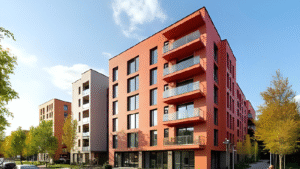Spain real estate has experienced a dramatic shift, with rental prices surging by 24% since the approval of the Housing Law. This change has led to a notable decrease in housing supply and a significant increase in demand, reshaping the rental landscape across the country.
The real estate landscape in Spain has undergone significant changes since the implementation of the Housing Law, which aimed to address the country’s housing crisis. Recent data from the real estate portal Idealista reveals that rental prices have surged by an astonishing 24% between May 2023 and April 2025. This article delves into the implications of the Housing Law, the dynamics of rental prices, and the shifting supply and demand in the Spanish rental market.
Understanding the Housing Law and Its Implications
The Housing Law, officially known as the Law for the Right to Housing, was enacted to provide greater protections for tenants and to regulate rental prices in an effort to make housing more accessible. However, the law has had unintended consequences, leading to a significant increase in rental prices and a decrease in the availability of rental properties.
Rental Prices on the Rise
According to Idealista’s report, rental prices across Spain have not only increased but have done so consistently over the past two years. The average rental price has risen by 24%, with certain regions experiencing even more dramatic increases. For instance, Segovia has seen a staggering 39% rise, followed closely by Valencia at 35%, Madrid at 31%, and Santa Cruz de Tenerife at 30%.
In major urban centers, the trend is similarly pronounced. Barcelona remains the most expensive city for renters, with an average price of €23.8 per square meter. Madrid follows at €21.4, while San Sebastián, Palma, Valencia, and Malaga also feature prominently on the list of cities with high rental costs.
Supply Shortages in the Rental Market
While rental prices have skyrocketed, the supply of homes available for permanent rental has plummeted by 17% since the Housing Law came into effect. This decline is particularly acute in cities like Córdoba, where the rental stock has decreased by 66%, and Oviedo, which has seen a 52% drop. Major cities like Barcelona and Madrid have also experienced significant reductions in available rental properties, with decreases of 46% and 21%, respectively.
The decline in supply is not uniform across the country. In some areas, such as Alicante and Valencia, the rental supply has seen modest increases, suggesting that local market conditions can vary widely.
Demand Dynamics: A 79% Increase in Interested Parties
The demand for rental properties has surged dramatically, with a reported increase of 79% in the number of interested parties since the Housing Law was enacted. In the first quarter of 2023, prior to the law’s implementation, there were an average of 19 families vying for each rental advertisement. This competition has intensified, with two-thirds of provincial capitals experiencing a doubling or more in the number of interested renters.
Cities like Bilbao and Seville have witnessed extraordinary competition, with increases of 194% and 142%, respectively. Even in Madrid, where the competition has increased by 60%, the demand remains robust, highlighting the ongoing challenges faced by renters in securing affordable housing.
The Shift to Seasonal Rentals
As the supply of permanent rental properties dwindles, many homeowners have turned to seasonal rentals as an alternative. Idealista reports a 25% year-on-year increase in the supply of seasonal rentals, which now account for 14% of the entire rental market in Spain. This shift indicates a strategic pivot by property owners seeking to maximize their rental income amid tightening regulations on permanent rentals.
In cities like Barcelona, nearly half of the available rental properties are now seasonal, reflecting a significant trend that could reshape the rental landscape. Other cities, such as San Sebastián and Badajoz, also show high proportions of seasonal rentals, while major markets like Madrid and Bilbao have lower percentages.
Regional Variations in Rental Markets
The rental market in Spain is characterized by significant regional variations. While major cities like Barcelona and Madrid dominate in terms of rental prices, other cities are experiencing different dynamics. For instance, Zaragoza and Murcia have seen rental price increases below the national average, at 19% each, while Las Palmas de Gran Canaria and Seville have experienced more modest increases of 16% and 15%, respectively.
The stark differences in rental prices and supply across regions underscore the complexity of the Spanish real estate market. Investors and renters alike must navigate these variations to make informed decisions.
Navigating the New Real Estate Landscape
The implementation of the Housing Law in Spain has led to a complex interplay of rising rental prices, declining supply, and increased demand. While the law aimed to protect tenants and improve housing accessibility, the unintended consequences have created a challenging environment for renters.
As rental prices continue to climb, and the supply of permanent rentals diminishes, potential tenants must be prepared for heightened competition and limited options. Meanwhile, property owners are increasingly turning to seasonal rentals as a viable alternative, further complicating the landscape.
For those looking to invest in Spain’s real estate market, understanding these dynamics is crucial. The current environment presents both challenges and opportunities, and staying informed will be key to navigating this evolving market. As the situation develops, stakeholders must remain vigilant and adaptable to the changing tides of Spain’s real estate market.









